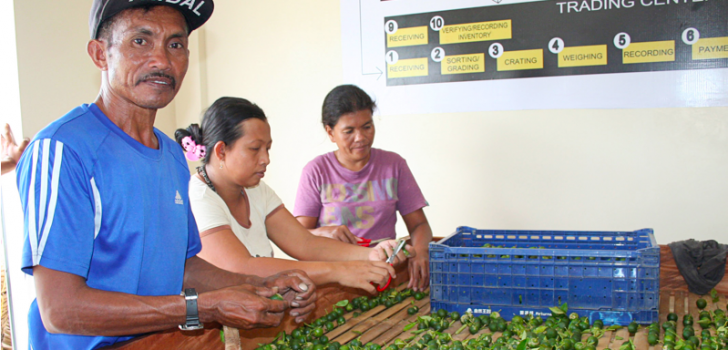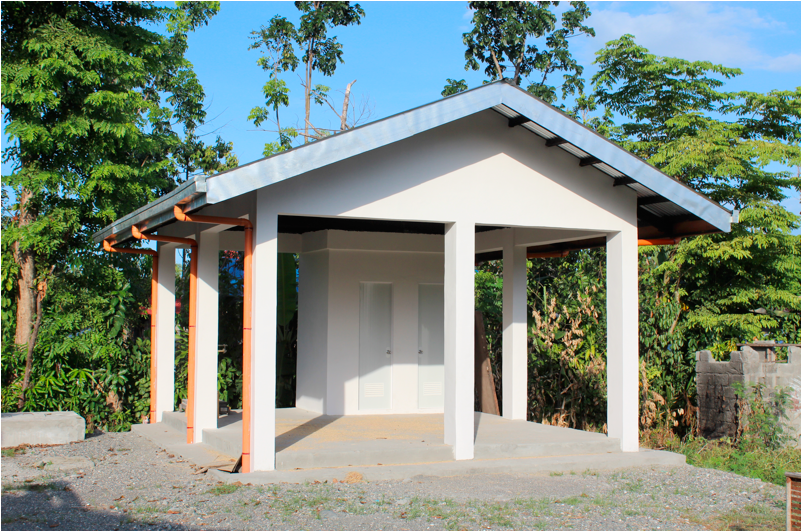 Workers at the Oriental Mindoro Calamansi Trading Center remove the stems and leaves of the calamansi fruit before sorting. Calamansi fruits have to be arranged by color or size depending on the preferences of the buyers. (Photo by Leira Vic Colongon, DA-PRDP RPCO 4B InfoACE Unit)
Workers at the Oriental Mindoro Calamansi Trading Center remove the stems and leaves of the calamansi fruit before sorting. Calamansi fruits have to be arranged by color or size depending on the preferences of the buyers. (Photo by Leira Vic Colongon, DA-PRDP RPCO 4B InfoACE Unit) PRDP-funded trading center gets thumbs up from calamansi farmers
There needs to be a more systematic and efficient way of distributing agricultural products if the production capacity of farmers as well as income are to be maximized.
That was the exact reason for the establishment of the “Oriental Mindoro Calamansi Trading Center and Buying Station” subproject proposed by the Naujan Farmers Association (NaFA) under the enterprise development (I-REAP) component of PRDP.
Oriental Mindoro has more than 2,000 calamansi producers and more than 3,000 hectares of calamansi plantation, making the province “King” of calamansi in the country.
In 2013, the MIMAROPA Region ranked first in the national production of calamansi. Because of limited market linkages, however, oversupply and low-buying price of calamansi especially during peak season affect farmers. Add this to damages brought by typhoons as well as pest infestations and farmers would not be earning enough.
“From what I know, one of the reasons why this project was established was to help farmers and one of the things that should be provided to them is assistance in marketing. The problem when farmers are harvesting their products is that they don’t know where to bring or sell it,” NaFA President Conrado Balmes said.
The price of raw calamansi significantly fluctuates during peak and lean seasons. Its lowest and highest estimated farm gate value varies from P5.00 to P30.00 per kilogram which restricts farmers to secure enough revenue.
The PRDP-funded enterprise intends to reduce the said development constraints and give calamansi farmers the opportunity to regain their losses. Calamansi produced by individual farmers will now be consolidated to cater the volume requirements of identified institutional markets. According to the NaFA management, this system should lead to a better market price that is more beneficial to small-scale farmers.
In addition, the member-beneficiaries of the trading center also aim to completely change the current trading system of calamansi in Oriental Mindoro. When farmers bring their products to regular traders, they usually have to wait for several days after the traders had sold their products for them to learn how much they have earned.
With the new trading center, a reasonable price has been set for calamansi and the farmers are paid with cash immediately after they bring their produce.

The Oriental Mindoro Calamansi Buying Station located in Poblacion III, Victoria, Oriental Mindoro will serve as a collection center of calamansi from farms located in Victoria, Socorro and Pola. (Photo by Elmo Morillo, DA-PRDP RPCO 4B InfoACE Unit)
“Now, calamansi farmers are encouraged because of the assistance being provided to them. This time, we are sure that we will be able to sell our calamansi and that it will not just be thrown away. This time, there is income for farmers. Calamansi farming contributed a lot in our lives, not just to me but also to the majority of farmers in the province,” NaFA Operations Manager Victor Ulayan said.
Ulayan also added that the establishment of the trading center and buying station will start a positive chain reaction not just for its beneficiaries. They will now have to create more jobs given that they will have to hire harvesters, cleaners, sorters, and more manpower that will become a part of their enterprise.
During the official visit of Department of Agriculture Secretary Emmanuel Piñol, he encouraged the NaFA to venture into other uses of calamansi for additional forms of livelihood. One of these is the processing of fresh calamansi into powder or puree. Through proper technology, the association can widen their horizon and develop more income-generating activities.
The NaFA, which was established and registered in 2009, continues to grow with already more than 400 member-beneficiaries. In addition to its members, the association also provides its services to other calamansi farmers in the province. The Tadyawan Tribe, a Mangyan community in the Municipality of Pola, is one of their existing clients. ### (Leira Vic Colongon, DA-PRDP RPCO 4B InfoACE Unit)
